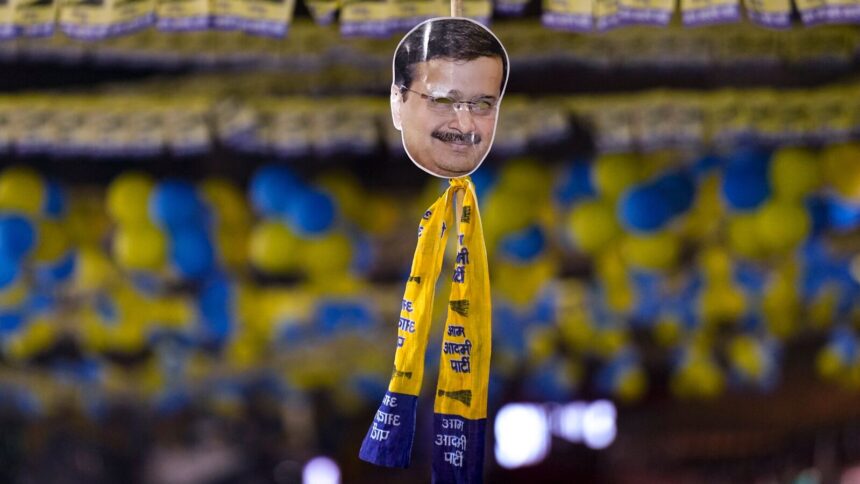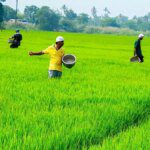In the midst of the noise and chaos, Jalvaid Yadav stands beside his fruit cart, closely observing each passerby, hoping to draw in customers. In his sixties, Yadav is eager for the Aam Aadmi Party (AAP) to regain power as Delhi prepares for elections on February 5.
His motivation? Former chief minister Arvind Kejriwal’s “pro-poor stance.”
“We yearn for a government that prioritizes the poor. Kejriwal has achieved much for Delhi. He has provided us with free water, free electricity, enhanced education and healthcare, established Mohalla Clinics (local centers offering essential medicines and tests in various neighborhoods of Delhi), and granted women free access to public transport. He genuinely cares for the less privileged,” Yadav states.
“We desire a government other than the (BJP) in Delhi. If the same party dominates everywhere, they will impose their will. In Delhi, we want Kejriwal; at the Centre, we support Modi,” he adds.
On the other side of the road, S.K. Pandey, a professor at a Delhi University College, and his friend, S.P. Verma, now retired, bask in the winter sun while chatting outside their residential colony. Behind them, a large open drain releases a foul odor every few moments. The neighborhoods appear rundown and neglected, with heaps of garbage and exposed manholes scattered throughout. Pandey and Verma are in favor of the BJP.
Their rationale? Prime Minister Narendra Modi’s emphasis on vikas (development).
“We appreciate Modi. He advocates for vikas and acts on it. Kejriwal hardly addresses development or vital issues like pollution, the Yamuna, or road conditions. He is distributing freebies funded by taxpayers. What’s the point? Look at the state of our roads, neighborhoods, and drains…no improvements have been made in any area,” Pandey passionately argues, with his friend nodding in agreement.
The contrasting viewpoints along the same street in Karawal Nagar epitomize this year’s Delhi assembly elections, characterized by two competing narratives. On one side is AAP’s robust pro-poor, welfare-centric agenda led by Kejriwal. Conversely, there are those critiquing the noticeable lack of infrastructural development during Kejriwal’s administration, opting instead for the BJP, which focuses on development.
AAP was victorious in this narrative clash five years ago. During the 2020 assembly elections, the party secured 62 out of 70 seats with a 54% vote share, leaving its main competitor far behind with only eight seats and a 38% vote share. Meanwhile, Congress, the third significant contender in the fray, ended up with nothing, garnering a mere 4.3% vote share.
AAP’s substantial 15 percentage point lead over BJP implies that there must be strong anti-incumbency sentiments against the party for BJP to make a significant impact this time.
The stakes
The contest for Delhi carries critical implications for its primary players, with high stakes for all.
For BJP, this is about prestige. Despite its significant victories in Delhi during Lok Sabha polls under Modi’s leadership—winning all seven seats in 2014, 2019, and 2024—success in assembly elections has been elusive, with Arvind Kejriwal safeguarding his domain and thwarting BJP’s ambitions to govern the state. In fact, BJP has not held power in Delhi since 1998, marking a 27-year-long wait to rule the national capital.
With no chief ministerial candidate, BJP is leaning entirely on the Modi brand, utilizing slogans such as ‘Modi ki guarantee’ (Modi’s guarantee). Consequently, the party is framing this election as a direct competition between Modi and Kejriwal. After setbacks in the 2024 Lok Sabha polling results, the party aims to maintain its popularity with credible performances in state elections.
For AAP, meanwhile, retaining control of Delhi is a fight for survival. It is one of the only two states, along with Punjab, where it is in power. Additionally, these elections are overshadowed by the current controversies surrounding the alleged liquor scam involving several AAP leaders.
Surprisingly, issues that might have been expected to ignite fervent debates—from the sheeshmahal controversy (BJP’s criticism of the AAP government regarding an extravagant renovation of the chief minister’s residence) to the alleged liquor scam—seem relatively insignificant on the ground. Among AAP’s supporters, there’s no palpable anger regarding the imprisonment or strong defense of the sheeshmahal. Meanwhile, AAP detractors or BJP supporters scarcely mention corruption in AAP’s regime. Thus, corruption is not a significant issue, undermining the BJP’s attempt to corner AAP, nor is Kejriwal being portrayed as a political victim, an outcome AAP had sought.
The third player, Congress, has an abysmal history in Delhi’s recent elections. Following a notably improved performance in the Lok Sabha in 2024, followed by two disappointing losses in other states, the party aims to start 2025 with at least a commendable showing in the national capital—a region it once ruled with pride.
Surprisingly, issues one would have assumed would ignite significant discussions—from the sheeshmahal controversy to the alleged liquor scam—appear rather trivial on the ground.
“The Delhi elections are evolving into an exhilarating contest, primarily between BJP and AAP. Although Congress is in the mix, it has not yet made a meaningful impact on voters to be considered a viable alternative,” comments Chandrachur Singh, political commentator and political science professor at Delhi University’s Hindu College. “The Congress resembles a competitor that possesses willpower but lacks the necessary competence or resources to compete effectively,” he adds. “I believe there is a noticeable decline in AAP’s credibility, especially among middle-class voters. Kejriwal’s image, I believe, has taken a hit,” Singh further asserts.
BJP is perceived as a nationalist party with a strong focus on development and leadership. Nevertheless, when it comes to local dynamics and governance, voters tend to divide along various lines—caste, class, and ethnicity.
“Regional affiliations and divisions play a critical role. Therefore, when you consider these factors together, you’ll discover that voting patterns, especially in state elections, differ significantly,” Singh explains.
The discourse over suvidha (benefits) versus vikas (development) among voters aptly encapsulates the AAP versus BJP rivalry.
AAP’s trump card
The Arvind Kejriwal-led government has built its political foundation on a governance model centered around welfare. This includes free water, free electricity (up to a certain limit), free bus rides for women, and what it claims is an improved education and healthcare system.
View Full Image
This remains the main emphasis of the ruling party—its support base, particularly among the economically disadvantaged, is rooted in this model. Building upon its welfare approach, AAP has introduced the Mahila Samman Yojana, which promises monthly cash assistance of ₹2,100 to women aged 18 and above.
Across East to West Delhi, Kejriwal’s bijli-paani (electricity-water) model maintains popularity among underprivileged sections.
Satish Kumar and Jai Singh, residents of Nangloi in western Delhi, praise Kejriwal while sitting at the latter’s paan stall.
“Everything about Kejriwal appeals to us. Paani, bijli, schooling, healthcare, women’s travel—yeh sab kaam badhiya hai (his accomplishments in water, electricity, education, healthcare, and free bus rides for women are commendable),” states Satish Kumar.
They are unfazed by the corruption allegations against Kejriwal. “Even the ED (Enforcement Directorate) hasn’t found anything incriminating against him. All these claims are groundless,” Kumar asserts.
In Badli, located in northwest Delhi, Raju operates a roadside tea and snacks stall off a busy road. “My daughters attend a government school, and I’ve witnessed tremendous improvements in infrastructure, teaching quality, as well as cultural aspects. Healthcare has also been a tremendous asset. I had a minor surgical procedure, and instead of high costs elsewhere, I received it for free and with excellent care in a Delhi government hospital,” he remarks, with others at his tea shop agreeing.
View Full Image
Bijli, paani but no roads
With Modi continuing to enjoy popularity in Delhi, BJP has been sidestepping the issue of its chief ministerial candidate, opting to approach these elections under his banner. The main grievance expressed by those disenchanted with AAP, however, is the evident lack of progress in infrastructure. By concentrating solely on social welfare, the AAP government has left a notable void in this area, even after a dozen years in power. As a result, some voters are leaning towards the BJP.
Suman Devi, in her 50s, sits at her husband’s paan and snack stall in Karawal Nagar, feeding a guava to her grandson. “I support Modi and wish to back BJP this time. Look at the state of the roads; they are worse than those in the most impoverished villages,” she asserts, pointing toward her neighborhood’s streets.
“I backed Kejriwal in the past elections. But now, I am inclined to vote for BJP, as AAP has failed to deliver. They haven’t constructed any roads or improved the drainage conditions. I’ve hardly benefited from their schemes. Humein toh gadhe ki poonch mili (all we’ve received is a donkey’s tail),” she adds.
Lal Kumar Rai and Prakash from Haiderpur, in northwest Delhi, are advocating for badlaav (change). Rai runs a tea stall while Prakash operates a small roadside barbershop.
“We need a shift in Delhi this time. No development has taken place in the city. We are voting under Modi’s name; it doesn’t matter that BJP lacks a strong candidate for now,” expresses Rai.
View Full Image
The BJP is evidently aware of the significant gap in AAP’s governance narrative. Earlier this year, just before the Election Commission of India (ECI) revealed the election dates for Delhi, PM Modi inaugurated a range of development projects in Delhi valued at over ₹12,200 crore.
With a strong desire for infrastructural development, there’s a lingering fondness and nostalgia for the Sheila Dikshit era—she served three consecutive terms from 1998 to 2013.
The deciding factors
Political factions are anticipating that a pivotal determinant of this election will be the female vote, which has emerged as an influential electorate in recent elections—most notably in the recent assembly polls in Maharashtra. Consequently, while AAP has introduced the Mahila Samman Yojana, Congress has proposed the Pyaari Didi Yojana, pledging a monthly cash transfer of ₹2,500 to women if elected. Not to be outdone, BJP, already adept in women-centered cash programs, promises a monthly financial assistance of ₹2,500 to women under the Mahila Samridhi Yojana.
This represents a “problem of plenty” for the women voters in Delhi, who are inclined to keep their options close to their chests and await to see if any of these promises materializes.
“We might not even receive this money. Everyone is merely making these pledges to woo us. One can only believe and reward parties once we actually receive these benefits,” says Mona, who runs a chola kulcha (savoury snacks) stall in Mundka, west Delhi.
Another variable in these elections is Congress’s role. To what degree will it impact the election, and which side will it ultimately advantage, particularly among the minority community?
Arvind Kejriwal is certainly aware of this. He has already cautioned voters against backing Congress, alleging it will merely “split votes.”
In this increasingly perceived two-party face-off between the ruling AAP and the hopeful BJP, the dialogue between Kejriwal and Modi persists, with suvidha and vikas in a fierce contest.










